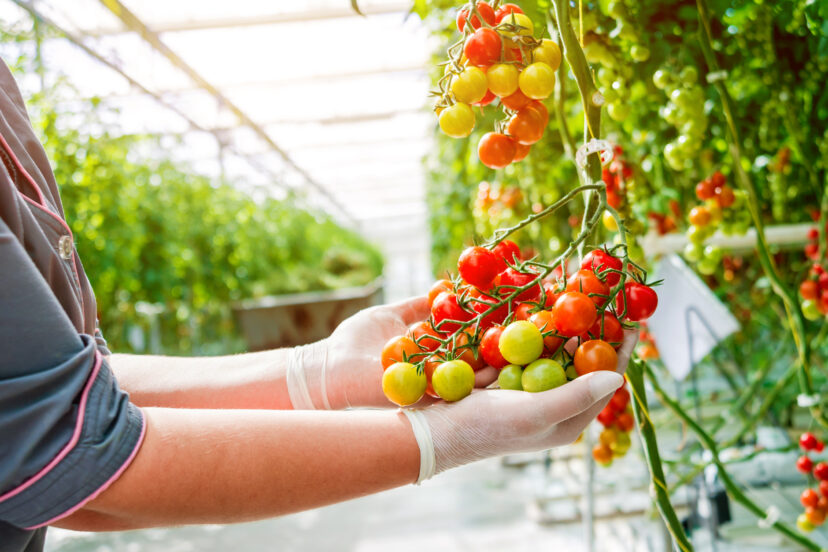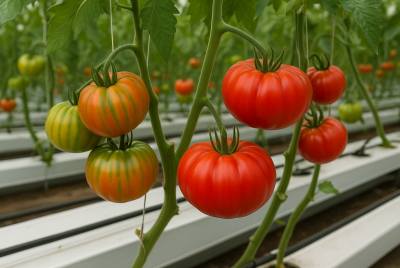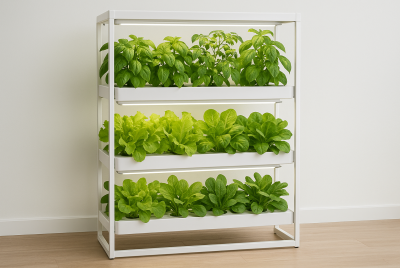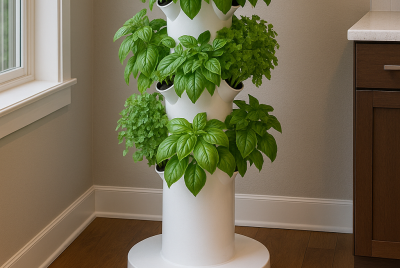How to Start Growing Hydroponic Tomatoes at Home
We may earn a commission for purchases made using our links. Please see our disclosure for more details.
Are you interested in rowing hydroponic tomatoes? Hydroponics can be challenging but with the right guidance, you can be successful even as a beginner. Imagine growing fresh, juicy tomatoes at home. Nice, right? If you’re ready to start gardening, here’s a step-by-step guide on how to grow delicious tomatoes efficiently.
What Are Hydroponic Tomatoes?
Hydroponic tomatoes are fresh tomatoes that are grown using nutrient rich water solution or via hydroponics system. No messy soil, fewer pests, and a much cleaner experience. Because of hydroponics, you can grow tomatoes year-round!!! Hydroponic systems are compact too, so even a tiny kitchen countertop can become your green oasis.
Why Choose Hydroponic Tomatoes?
Why hydroponics, you ask? It’s the superhero of gardening methods—saving water, maximizing space, and giving you juicy, flavorful tomatoes faster than traditional gardening. Whether you live in a high-rise or a cozy home, you can bring this efficient system to life. Bonus: it’s an eco-friendly option, as it minimizes chemical use and makes gardening more accessible for everyone.
Are Hydroponic Tomatoes Right for You?
If you’re dreaming of fresh produce, enjoy experimenting with new hobbies, or simply want to wow your friends with garden-to-table creations, this is your moment. Hydroponics doesn’t require a green thumb, just a bit of curiosity and patience. It’s like cooking—you don’t need to be a chef to enjoy the process and savor the results.
Picking the Perfect Tomato Varieties
Selecting the right tomato variety is like choosing your favorite dessert—they’re all good, but some fit better than others. Cherry tomatoes are speedy growers and perfect for snacking. Roma tomatoes make your sauces sing, while beefsteak tomatoes provide those picture-perfect sandwich slices. Mix and match to keep things interesting—you might discover a new favorite along the way.
Choosing the Right Hydroponic System
The world of hydroponic systems might feel like a maze at first, but it’s simpler than it sounds. Start with these options:
- Deep Water Culture (DWC): The beginner’s best friend—easy, effective, and budget-friendly.
- Nutrient Film Technique (NFT): Ideal for tight spaces, with a thin, nutrient-rich stream nourishing your plants.
- Ebb and Flow: A tech-lover’s dream—automated and efficient.
- Drip System: Slow and steady wins the race, with a consistent nutrient supply.
If in doubt, start small with DWC. Like learning to ride a bike, you can upgrade once you’re confident.
Setting Up Your Hydroponic Tomato System
Assembling your hydroponic system is like piecing together a puzzle—each part clicking into place with purpose. You’ll need a container for your plants, a nutrient mix, a pump, and some grow lights. Imagine crafting a tiny kingdom where your tomatoes reign supreme. Step by step, you’ll see it come alive, and the initial effort will soon feel like second nature.
Finding the Best Spot for Your Setup
Tomatoes are sun worshippers. Whether it’s a sunny windowsill or a dedicated grow light, ensure they bask in 12–16 hours of light daily. It’s like giving them their very own sun-soaked vacation, right at home. Keep them cozy and avoid drafts—it’s all about making them feel cherished.
Preparing the Nutrient Solution
Here’s where the science meets art. Think of the nutrient solution as a gourmet meal for your plants, perfectly balanced with nitrogen, phosphorus, potassium, and trace minerals. Premade mixes simplify the process, but the real magic happens when you see your tomatoes thriving on this tailor-made feast.
Research highlights the importance of nutrient solution management in maximizing hydroponic tomato yields. A study published in HortScience demonstrated how tailored nutrient delivery significantly enhances both yield and plant morphology in hydroponic systems. Complementing this, HortTechnology explored the impact of nutrient management and environmental conditions in deep water culture systems, offering practical insights for home gardeners. Together, these findings emphasize the critical role of proper nutrient management for achieving robust and productive hydroponic tomato plants.
Starting with Seeds or Seedlings
Starting from seeds feels like watching a secret unfold, one sprout at a time. But if patience isn’t your virtue, seedlings are a great shortcut to success. Either way, nurturing those tiny plants into fruit-bearing wonders will feel nothing short of miraculous.
Planting Your Tomatoes in the System
Nestle your seeds or seedlings into their growing medium, like coco coir or rock wool, and watch them settle into their new home. Give them space to breathe and grow—it’s like arranging a dinner party where everyone gets their own spot at the table.
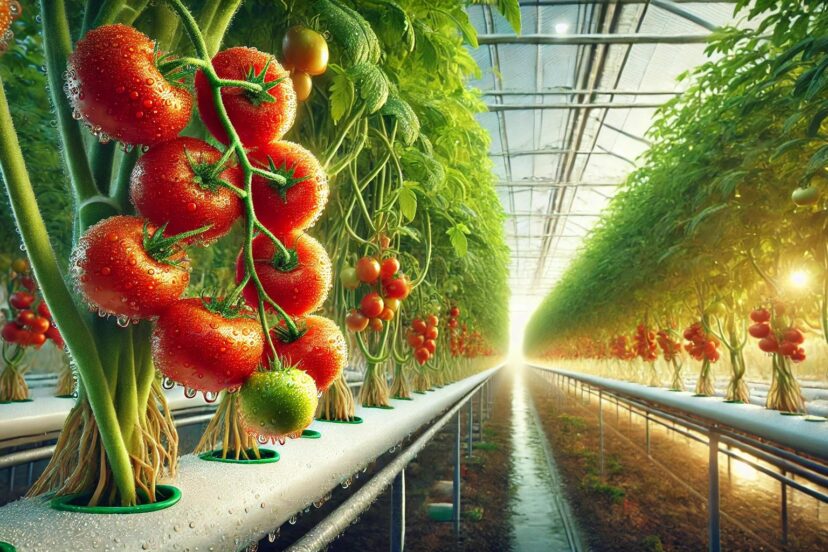
Maintaining the Perfect Environment
Consistency is your best friend here. Tomatoes love warmth and steady humidity. Treat them like VIPs by keeping the temperature between 65°F and 85°F. They’ll reward you with lush growth and vibrant fruit.
Monitoring pH Levels
Tomatoes have their quirks—they prefer their nutrient solution’s pH to stay between 5.5 and 6.5. Think of it as their sweet spot. A quick check with a pH meter will ensure everything stays just right. If the pH strays, a simple adjustment with pH up or down solutions can bring it back in line. Regular checks help prevent nutrient lockout, which could leave your tomatoes undernourished and unhappy.
Watering Schedule and Nutrient Management
Unlike traditional gardening, hydroponics takes the guesswork out of watering. It’s a steady stream of care, with regular nutrient refreshes keeping everything balanced. Think of it as your plants sipping from a never-ending fountain of goodness. Don’t forget to completely change the nutrient solution every two weeks to avoid salt buildup and keep your plants thriving. Monitoring the water level ensures your roots stay hydrated without drowning.
Pruning and Training Your Tomato Plants
Tomatoes, left unchecked, can become unruly. Trim their lower leaves and guide their growth upward with stakes or trellises. It’s like giving them a haircut and a posture lesson, all in one. Regular pruning improves airflow, reducing the risk of diseases. Plus, it channels the plant’s energy toward fruit production rather than excess foliage. If you want to grow more plants, read our guide on hydroponic lettuce.
Recommended Products for Growing Hydroponic Tomatoes
Here’s a curated list of essential products to kickstart your hydroponic tomato garden. These tools and supplies will make your journey smoother and more productive:
Hydroponic Systems
- Deep Water Culture Kit: A beginner-friendly system that’s easy to set up and maintain.
- NFT System: Ideal for small spaces, offering efficient water and nutrient flow.
Grow Lights
- LED Grow Lights: Energy-efficient and customizable to your tomato plants’ needs.
- Full-spectrum lights: These imitate sunshine to promote healthy growth.
Nutrient Solutions
- Hydroponic Tomato Nutrients: Balanced blends of nitrogen, phosphorus, and potassium.
- Liquid Fertilizers with Trace Elements: Ensures complete nourishment for healthy plants.
Growing Mediums
- Coco Coir: A natural, eco-friendly medium that retains moisture.
- Rock Wool Cubes: Provides excellent root support and aeration.
- Clay Pebbles: Ideal for maintaining consistent water and oxygen levels.
Monitoring Tools
- pH Meter: Essential for maintaining the optimal pH range (5.5–6.5).
- TDS/EC Meter: Measures the nutrient concentration in the solution.
With these products, you’ll have everything you need to grow thriving hydroponic tomatoes at home. Would you like links to purchase these items?
Identifying and Preventing Common Issues
Even in a hydroponic paradise, challenges can pop up. Keep an eye out for yellowing leaves, root rot, or leggy growth. With a bit of vigilance, you’ll catch problems early and keep your garden thriving. Be proactive by inspecting your plants daily for pests, nutrient deficiencies, or signs of stress. Addressing small issues promptly prevents them from snowballing into bigger problems.
Pollination: Helping Your Plants Set Fruit
Pollination in a hydroponic setup is a hands-on affair. A gentle shake or a tiny brush mimics nature’s touch, ensuring your tomatoes flourish with fruit. Doing this every few days during flowering season increases the chances of a bountiful harvest. Consistent pollination not only boosts yield but also enhances the shape and quality of your tomatoes.
Harvesting Your Hydroponic Tomatoes
The moment you’ve been waiting for! Harvest your tomatoes at peak ripeness, savor their flavor, and marvel at what you’ve accomplished. Every bite is a testament to your care and dedication. Pick them as they ripen to encourage continuous fruit production. Sharing your homegrown tomatoes with friends and family makes the experience even sweeter.
Reaping the Rewards
Growing hydroponic tomatoes is more than just a hobby—it’s a journey toward self-sufficiency, sustainability, and incredible flavor. Each plant is a reminder that with a little effort, you can create something extraordinary right at home. So, enjoy the abundant harvest, the fruits of your labor, because hey, you’ve earned it!
Why This Hobby Is Worth It
Hydroponics isn’t just about growing food; it’s about cultivating a lifestyle. Imagine turning your urban space into a vibrant oasis, where fresh produce is always within arm’s reach. Whether you’re in a bustling city or a quiet suburb, this hobby offers a sense of connection—to nature, to sustainability, and to the simple joy of nurturing life.
By growing hydroponic tomatoes, you’re making a statement: fresh, healthy, and eco-friendly living is possible, no matter where you are. It’s an investment in yourself, your family, and the planet. And the best part? It’s deliciously rewarding.
Check this out:
Summary
Growing hydroponic tomatoes at home is more than just a gardening project—it’s a step toward a sustainable, healthier lifestyle. From choosing the perfect tomato varieties to creating a nurturing environment, every step is an opportunity to learn, grow, and savor the fruits of your labor. Whether you’re an experienced gardener or a curious beginner, this journey promises to be as enriching as the produce it yields.
FAQs
- Can tomatoes be grown hydroponically without LED grow lights?
Yes, but only if you have a sunny spot that offers 12–16 hours of natural light daily. If not, grow lights are essential to ensure robust growth. - How much time does it take to grow hydroponic tomatoes?
Most varieties take 8–12 weeks from seed to harvest, depending on the type and growing conditions. - Are hydroponic tomatoes as flavorful as soil-grown ones?
Absolutely! Many enthusiasts argue they taste even better because you can control the nutrients and growing environment. - What is the cost of setting up a hydroponic tomato system?
A basic system can cost anywhere from $50 to $200, while more advanced setups may be pricier but offer greater convenience and scalability. - Can I reuse the nutrient solution?
Yes, but it’s crucial to monitor and refresh it regularly to maintain the correct balance of nutrients and prevent contamination.

